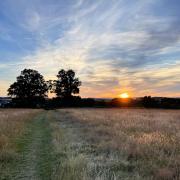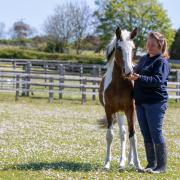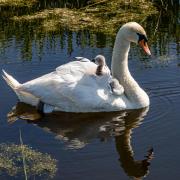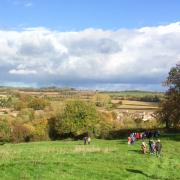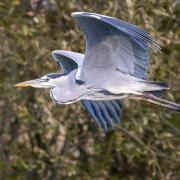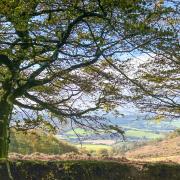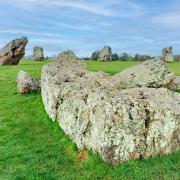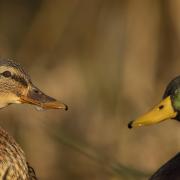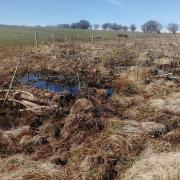RSPB Ham Wall in Somerset is a true gem of a nature reserve all year round. Large swathes of freshwater reedbeds give way to open water, creating a paradise for wetland birds, mammals, and minibeasts. The nature reserve is cared for in a way that creates just the right homes and conditions for its wildlife to thrive.
Summer nature highlights
July is traditionally a quieter time on nature reserves, particularly for birds. Parent birds are tired after a busy breeding season raising chicks and often rest in the heat of the day but at RSPB Ham Wall there’s always something amazing happening when you look a little closer. Sometimes it just takes a little patience and time, but it’s certainly a place where you can just be still and enjoy the pause from busy life that greenspaces offer.
Take a seat at one of the reserve’s hides or screens, one of the viewing platforms or the many benches in the shade then sit back and wait. Enjoy the beautiful birdsong from the tree lines along the main track. Blackcap, chiffchaff, willow warbler and garden warbler will all still be in song along with blackbirds, robins, song thrush, and finches contributing to the chorus.
The reed beds are alive with noise too. Reed warblers and sedge warblers are still present with their chattering calls. The punchy song of the cetti’s warbler is hard to miss and the squeal of the Water Rail cuts through all the other noise. They can often be seen from the Tor View Hide throughout the year. The Tor referred to here is of course Glastonbury Tor, an unmissable landmark in the local landscape.
Many young birds are taking their first steps this month (or flights) of independence, whilst others are still quite reliant on their parents. Young Marsh Harriers can be seen interacting with adult birds performing food passes in mid-air, learning the co-ordination and aerial skills they will need to survive.
Great crested grebes dive for small fish for their stripey youngsters, young coot and moorhen flit in and out of the reeds, buzzards soar high up on thermals and barn owls can be seen out in the day on the hunt for small mammals to feed well grown owlets.

Another bird of prey to seek out is the acrobatic Hobby, which recently delighted viewers in the Freshwater Episode of BBC Wild Isles, filmed right here at RSPB Ham Wall. These birds love to feed on the 20 or more species of dragonfly and damselfly that live on the reserve – they can be seen plucking the insects out of mid-air and it’s fantastic to watch these skilled hunters at work.
They arrive in early May and peak a couple of weeks later as they pass through to their breeding grounds, using RSPB Ham Wall as a convenient feeding station as part of their journey. Some stay on and can be seen daily during the summer months. Their arrival coincides with the large emergence of damselflies and dragonflies on the reserve with the Four Spotted Chaser emerging in their thousands. They are still present in July and August although in lower numbers.

All of a flutter
It’s the buzz and energy of insect life that really defines RSPB Ham Wall in the summer months. Emperor dragonflies (our largest dragonfly species) patrol their territories, bumblebees and hoverflies, are on the wing, and red-eyed damselflies perch on floating vegetation.
One of my favourites is the banded demoiselle, which flutter along the edges of the main waterway through the reserve. The male has a wonderful metallic blue body and sports dark bands across its wings. Although the female lacks these bands, she has a gorgeous metallic green body. The males court females by opening their wings and performing an aerial dance. Take a good look at the vegetation at the water's edge to see how many different species of damselfly you can see, some look very similar but have subtle differences. You may even encounter the much rarer white legged damselfly.
Butterflies are always a firm favourite at RSPB Ham Wall. Several species can be spotted throughout the summer months including red admiral, gatekeeper, meadow brown, ringlet, small copper, comma, speckled wood, brimstone, green veined white, small white, common blue and small tortoiseshell. Painted lady can also be seen at this time of year and the silver washed fritillary is always a treat, but harder to spot. A couple of sightings of purple hairstreak in July last year was also fantastic. Look up in the canopy of oak trees for these, you never know your luck.
The smaller insects on the wing are providing food for swallows, house martins, sand martins and swifts which can be seen swooping low over the water. They need to take in as much energy as possible to build up strength for the long migration back south and RSPB Ham Wall is the perfect place to do it.
Marvellous mammals
A wide variety of mammals make their home at RSPB Ham Wall too. A number of these can prove quite elusive such as stoats, weasels, water voles, or the incredible otter, perfectly suited to this landscape. They are not seen often but it’s a special experience when you do, it really lifts the spirits.
Roe deer can be seen grazing the grassy paths on the quieter trails around the reserve, where it is still possible to get away from the busier areas and really feel alone in this ancient looking landscape. Although the site has been created from the old peat workings it feels reminiscent of what may have been here many years before.
You may hear the calling of Iberian water frogs in the many pools and areas of open water, as their name suggests they are originally from outside the UK. For many new bird species moving north and colonising the UK, this will be a familiar sound and they provide good fodder for birds such as the great white egrets and our resident bitterns.
Our native common frogs breed much earlier and by summer many small froglets can be seen hopping around the reserve, so be careful where you tread. These too are a good food for birds, but also the many grass snakes on the reserve. You may be lucky enough to see a grass snake sunning themselves on bank edges or even swimming in front of the viewing screens.
Common lizard and slow worms can also be seen warming themselves up during sunny spells, all adding to the rich variety of wildlife you may encounter on your visit.

Celebrating 15 Years of booming!
RSPB Ham Wall is perhaps best known for its booming bitterns. In fact, the reserve was created from old peat workings, specifically as a home for them and this year the site celebrates the 15-year anniversary of male bitterns breeding amongst its reedbeds.
The ‘boom’ is the mating call of the male bittern. This eerie sound is like someone blowing across the top of a glass bottle only much louder. Once you’ve heard it, it’s unmistakeable and it can be heard up to 5km away – Britain’s loudest bird. Bitterns boom to attract a mate in early spring, but by now they will have paired up and be busy raising chicks. You may catch a glimpse of parent birds flying over the reedbeds, foraging for hungry youngsters.
The reedbeds of the UK had become almost devoid of the bittern’s amazing call, when RSPB Ham Wall first began to be formed in 1994. By 1997 just 11 booming bitterns remained in the whole country. Thanks to the hard work of the RSPB, countless volunteers, and valuable partnerships with Natural England and the Wildlife Trusts, bitterns are thriving not just here in Somerset, but across the country.
It did take until 2008 until RSPB Ham Wall had its first breeding success. I can still remember the thrill of hearing my first booming Bittern on the reserve, it was a momentous occasion, and all the hard work of staff and volunteers was finally paying off.
Since then, numbers have continued to build, and last year saw 22 booming males on RSPB Ham Wall alone, double the UK figure for 1997. A real conservation success story and evidence that things can be turned round.
This careful management of reedbeds has positive consequences for other species too. New colonisers such the great white egret have arrived and thrived across the Avalon Marshes (of which RSPB Ham Wall is a part). These elegant birds are hard to miss on a visit to the reserve with over 40 nests spread across the Avalon Marshes last year, they’re certainly a bird on the up. Cattle egret and little bittern have also bred in recent years at RSPB Ham Wall and even more recently the frequent presence of several splendid glossy ibis has excited visitors.
Bringing people closer to nature
The reserve has also developed in other ways to help bring nature closer to people, to engage and enthuse visitors of all ages, whether they are totally new to nature or a regular outdoors explorer. Ample parking and a friendly welcome are always a good start, toilet facilities and light refreshments are also available – including delicious ice creams, perfect for summer days.
There are plenty of benches to sit and enjoy the reserve and some picnic areas if you want to spend a little longer with us and enjoy some food in peaceful surroundings. We have recently installed a play area for children too with a little viewing tower just for kids to see what wildlife they can spot across the reedbeds.
Whatever your passion, whether it be birds, insects, plant life or just the sheer enjoyment of a walk in the countryside, there’s something for everyone to enjoy this summer at RSPB Ham Wall.




